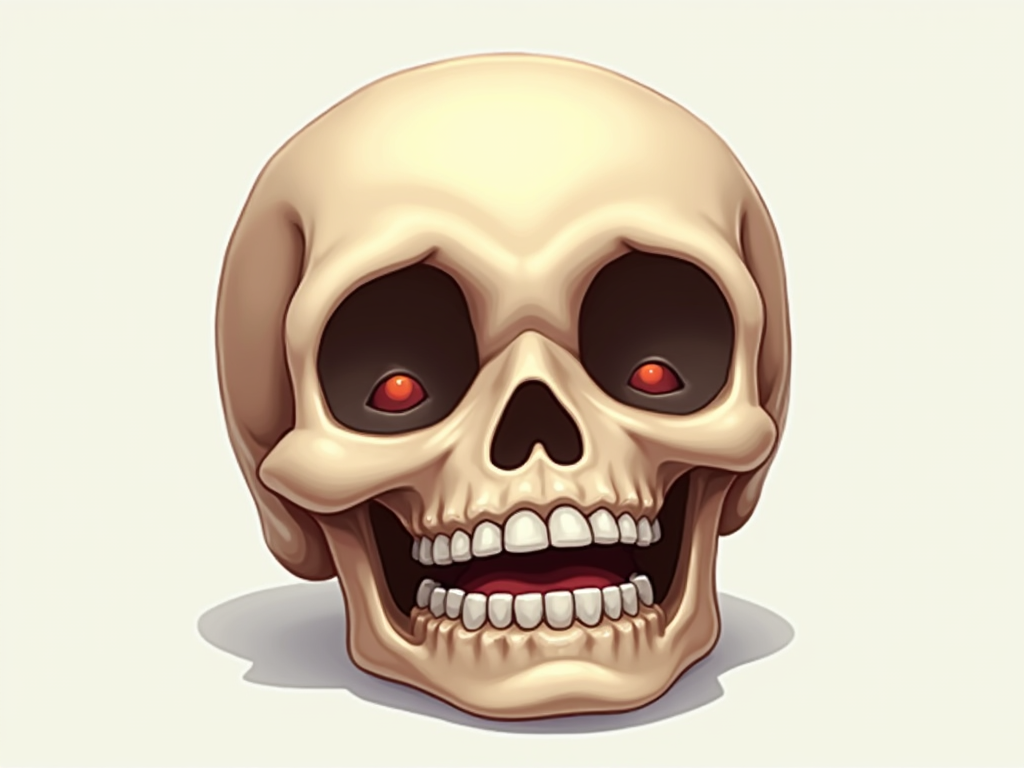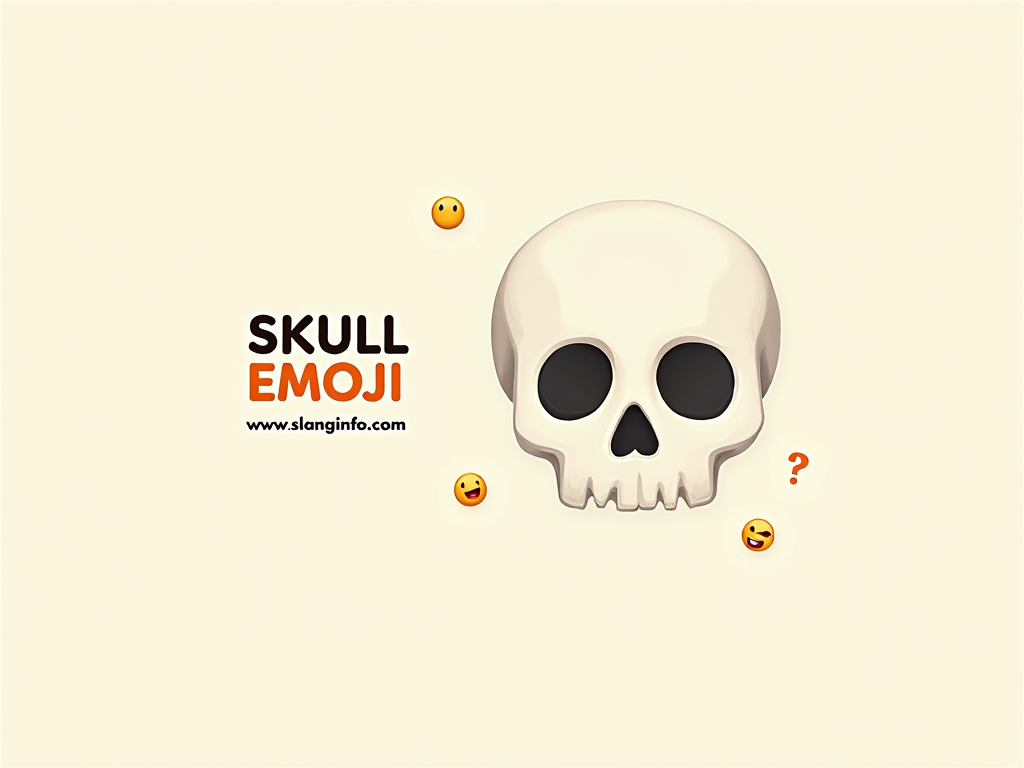Ever sent a skull emoji 💀 and wondered if your friend might think you’re plotting their demise? Don’t worry, you’re not alone! This little bone-headed character has taken on a life of its own in the digital world. Let’s dive into the wild and wacky world of the skull emoji and uncover its many faces.
| Key Takeaways | Meaning |
|---|---|
| Primary Uses | Laughter, exhaustion, embarrassment |
| Traditional Meaning | Death, danger |
| Modern Interpretation | Humor, exaggeration |
| Context Matters | Can change meaning dramatically |
| Cultural Sensitivity | Use cautiously in some regions |
Skull Emoji 💀

What’s the Deal with 💀?
Alright, let’s get down to the nitty-gritty. The skull emoji 💀 isn’t just for Halloween anymore. Nope, this little guy has become the Swiss Army knife of emojis. It’s like the GOAT of expressing extreme emotions. But here’s the kicker – its meaning can change faster than you can say “boo!”
From Deadly to Hilarious
- LOL on Steroids: When something’s so funny you can’t even type “haha,” 💀 comes to the rescue. It’s like saying, “I’m dying of laughter” without the effort of typing all those words.
- The Ultimate Facepalm: Embarrassed yourself in front of your crush? 💀 is there to express your soul leaving your body from sheer mortification.
- Dead Tired: After a day that feels like it lasted a year, 💀 perfectly captures that “I’m so exhausted I might actually be dead” vibe.
How to Use 💀 Without Freaking People Out
Using 💀 is like walking a tightrope. One wrong move and you might end up in a goofy ahh situation. Here’s how to nail it:
- Know Your Audience: Your grandma might not appreciate a 💀 in response to her cookie recipe.
- Context is King: “Can’t wait for our date tonight 💀” hits different than “That joke was hilarious 💀”.
- Quantity Matters: One 💀 is funny, ten in a row might make people worry about your mental state.
The Cultural Rollercoaster of 💀
Here’s where it gets tricky. The skull emoji is like American vs. British slang – it doesn’t always translate well:
- Western World: Generally seen as humorous or exaggerative.
- Some Eastern Cultures: Might be taken more seriously or as disrespectful.
- Business Settings: Proceed with extreme caution. Your boss might not appreciate your “dead from workload 💀” status update.
💀 in the Wild: Real-Life Examples
Let’s see this bad boy in action:
- “Just finished a 10-hour gaming session 💀” (Translation: I’m exhausted but it was worth it)
- “Saw my ex at the grocery store 💀” (Translation: This was the most awkward moment of my life)
- “That meme you sent me 💀💀💀” (Translation: It was so funny I couldn’t even type)
The Cultural Rollercoaster of 💀
Here’s where it gets tricky. The skull emoji is like American vs. British slang – it doesn’t always translate well:
- Western World: Generally seen as humorous or exaggerative.
- Some Eastern Cultures: Might be taken more seriously or as disrespectful.
- Business Settings: Proceed with extreme caution. Your boss might not appreciate your “dead from workload 💀” status update.
💀 in the Wild: Real-Life Examples
Let’s see this bad boy in action:
- “Just finished a 10-hour gaming session 💀” (Translation: I’m exhausted but it was worth it)
- “Saw my ex at the grocery store 💀” (Translation: This was the most awkward moment of my life)
- “That meme you sent me 💀💀💀” (Translation: It was so funny I couldn’t even type)
The Evolution of 💀: From Spooky to Silly
The skull emoji has come a long way, baby. Here’s a quick timeline:
- 2010: Introduced as a literal skull symbol. Spooky vibes only.
- 2016-2017: Started gaining traction as a humorous reaction.
- 2018-2019: Became Gen Z’s go-to for self-deprecating humor.
- 2020-Present: Now it’s everywhere, from memes to mental health discussions.
It’s like watching the glow-up of an emoji in real-time!
How to Use 💀 Like a Pro
Want to flex your emoji skills? Here are some pro tips:
- Context is Key: “Can’t wait for our date tonight 💀” hits different than “Just aced my exam 💀”.
- Quantity Matters: One 💀 is funny, ten in a row might make people worry about your mental state.
- Mix and Match: Combine with other emojis for extra impact. “That joke was so bad 💀😂” tells a whole story.
The Dark Side of 💀
While mostly used for laughs, the skull emoji can have a serious side too:
- Mental Health Discussions: Sometimes used to talk about depression or anxiety in a relatable way.
- Social Commentary: Can be a way to react to heavy news or social issues.
- Potential Misunderstandings: Always consider your audience. Not everyone gets the joke.
Wrapping It Up: The Power of 💀
So there you have it – the skull emoji in all its bony glory. From throwing shade to expressing sheer joy, this little icon packs a punch. It’s more than just a digital doodle; it’s a reflection of how we communicate in the 21st century.
Remember, emojis are like seasoning in your text soup. Use them to add flavor, but don’t overpower the message. And hey, if you’re ever in doubt, there’s no shame in asking “What does that emoji mean?” We’ve all been there!
Now go forth and emoji with confidence! Just remember – with great power comes great responsibility. Use your 💀 wisely, and may your digital conversations be ever witty and never misunderstood!







